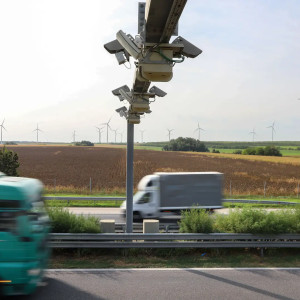Tolls overtake fuel in Europe’s truck costs


The organisation's Driving profitability: Fuel, tolling and cost trends in the EU briefing shows that environmental charges and the introduction of a CO2 component under the revised Eurovignette Directive are transforming the cost structure of European road freight.
The IRU notes that fuel and tolls[1] together represent a major share of a truck's total cost of ownership (TCO), with tolls now accounting for up to 15 per cent of TCO in Germany, excluding staff and overhead costs[2].
"Tolls have become a decisive factor in operational costs," the report states, adding that the shift reflects how "charges are increasingly tied to both infrastructure wear and environmental performance".
Tolls exceed fuel in Austria, Germany and Hungary
Data compiled by the IRU shows that in several countries, per-kilometre toll fees now surpass the cost of fuel. In Austria, the toll rate for a Euro VI articulated lorry[3] can reach EUR0.62 per km, while the corresponding fuel intensity is around EUR0.46 per km. In Germany[4], the CO2-based surcharge introduced in 2023 pushed tolls for Euro VI vehicles up by 83 per cent, making them higher than fuel expenditure on many routes.
A similar pattern has emerged in Hungary[5], where the largest Euro 0 vehicles pay EUR1.48 per km, more than double the cost of fuel.
The widening gap is mainly attributed to the mandatory inclusion of CO2 emissions in toll calculations[6]. Nine EU Member States had introduced the new component by mid-2025, with others preparing to follow. Denmark's switch from a vignette to a distance-based system[7] caused a five-fold (500 per cent) increase in average truck tolls, while the Netherlands plans to implement a similar model[8] in July 2026.
Fuel costs fall but taxation remains decisive
While tolls rise, fuel prices have stabilised[9]. The IRU recorded a weighted EU average diesel price of EUR1.54 per litre in August 2025, 2.6 per cent lower year on year and 22 per cent below 2022 levels.
Prices nevertheless vary widely across the bloc, from EUR1.21 in Malta to EUR1.87 in Ireland, largely due to taxation.
Across the EU, taxes make up around half of the pump price, the report shows. Excise duty averages EUR0.45 per litre, but ranges from EUR0.33 in Bulgaria to EUR0.63 in Italy. Italy also has the highest overall tax share-- 61 per cent --while Estonia sits at the lower end with 45 per cent.
Several countries, including France, Italy, Spain and Hungary, offer partial excise duty rebates to freight operators, in some cases reducing the effective rate to the EU minimum.
Breaking down the price structure, the IRU calculates that the crude-oil component accounts for about 34 per cent of the final retail price. Distribution costs have risen sharply, reaching EUR0.21 per litre in 2024, a 133 per cent increase since 2015, while refining costs dropped 55 per cent between 2022 and 2024.
Alternative fuels gain ground
Diesel remains the benchmark[10] for long-distance transport, but the composition of running costs is changing. Hydrotreated Vegetable Oil[11] (HVO)--a renewable diesel--was on average 22 per cent more expensive than fossil diesel in 2025, except in Italy, where local production makes it marginally cheaper. Its carbon intensity is about 90 per cent lower than diesel, and it can be used in conventional engines without modification.
Compressed natural gas[12] (CNG) prices have stabilised after the energy-market volatility of 2022. In 2025, CNG sold for EUR1.04 per kg in Poland and EUR1.27 per kg in Spain, while the EU's pre-tax natural-gas price averaged EUR0.55 per kg in 2024.
The report also highlights that electricity for depot charging fell to EUR0.14 per kWh in 2024, down 22 per cent year on year, though public charging remains above EUR0.40 per kWh.
Policy now shapes profitability
According to the IRU, "the profitability of European freight transport depends less and less on crude oil prices and more on national fiscal and environmental choices." With the EU's Emissions Trading System[13] for road transport (ETS 2) scheduled to take effect in 2027, an additional EUR0.12 per litre could be added to diesel prices as suppliers pass on carbon-allowance costs.
The combined effect of CO2-linked tolls and fuel taxation is already altering fleet strategies. IRU data show that the average toll for a Euro VI truck is EUR0.10 per km, compared with EUR0.036 per km for a zero-emission vehicle-- a 64 per cent reduction. In Germany, battery-electric[14] and hydrogen[15] trucks are fully exempt from tolls, making them cheaper to operate over time than diesel vehicles despite higher purchase costs.
A new cost hierarchy for hauliers
The report concludes that operators must now plan around environmental levies as much as fuel markets.
Distance-based and CO2-adjusted toll systems are becoming the European norm, and the resulting price differentiation "strongly incentivises fleet renewal, even if a full transition to zero-emission vehicles is not yet feasible".
With tolls exceeding fuel costs on major corridors and further reforms under way, the IRU's findings suggest a fundamental restructuring of road freight economics.
For many hauliers, profitability will hinge not on global oil prices but on how effectively they navigate Europe's evolving toll and tax landscape.
References
- ^ tolls (trans.info)
- ^ staff and overhead costs (trans.info)
- ^ the toll rate for a Euro VI articulated lorry (trans.info)
- ^ Germany (trans.info)
- ^ similar pattern has emerged in Hungary (trans.info)
- ^ CO2 emissions in toll calculations (trans.info)
- ^ Denmark's switch from a vignette to a distance-based system (trans.info)
- ^ the Netherlands plans to implement a similar model (trans.info)
- ^ fuel prices have stabilised (trans.info)
- ^ Diesel remains the benchmark (trans.info)
- ^ Hydrotreated Vegetable Oil (trans.info)
- ^ Compressed natural gas (trans.info)
- ^ Emissions Trading System (trans.info)
- ^ battery-electric (trans.info)
- ^ hydrogen (trans.info)